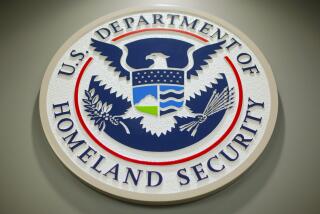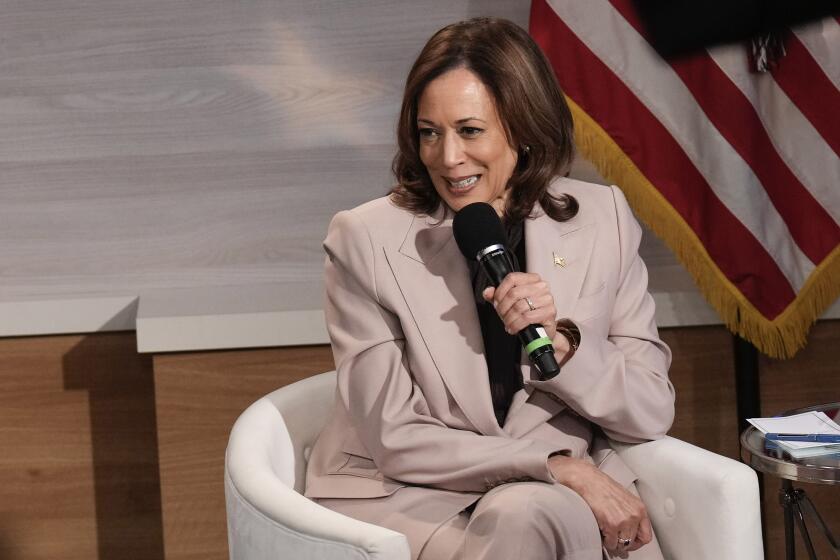Trump uses expansive definition of ‘emergency’
President Trump declared a national emergency last week -- in a tweet.
Aiming his ire at a caravan of migrant families hundreds of miles from the United States, Trump vowed he was “bringing out the military for a National Emergency.” His administration then authorized sending more than 5,000 active-duty troops to the border.
But Trump has filed no legal proclamation declaring a national crisis as required under a 1976 law enacted to rein in abuses of executive power by granting presidents additional authorities only in specific instances and for a limited time frame.
For Trump, the caravan is an emergency merely because he said so.
Critics said the president’s approach represents another measure of his willingness to act outside the bounds of his predecessors -- in this case using an official term to portray migrants as dangerous and to stoke public fears ahead of next week’s midterm elections.
They warned that Trump is priming supporters to place their faith solely in his judgment over what warrants an emergency response from the executive branch. Their fears grew more acute this month when the Federal Emergency Management Agency tested a new presidential alert system, which allows the White House to issue notifications to every cellphone in the nation.
Norman Ornstein, a political analyst at the conservative American Enterprise Institute, said the 1976 National Emergencies Act was intended to offer the public a clear White House rationale for pursuing emergency actions -- a safeguard that Trump has circumvented with his impetuous nature and loose language.
The law “is in some ways built on the assumption a president will use it appropriately when there is an emergency,” Ornstein said. “We have to challenge all our assumptions right now. I find it chilling.”
Trump’s predecessors often invoked the 1976 law when facing down crises they believed threatened the nation.
President George W. Bush, for instance, declared a national emergency on Sept. 14, 2001, in the wake of terrorist attacks in New York and Washington. Alerting Congress through a formal proclamation, Bush moved to gain additional legal powers over the U.S. military. Nine days later, he declared a second emergency - to pursue economic sanctions on terrorist groups.
Since running a campaign focused heavily on threats from abroad -- including immigration, terrorism and predatory trade -- Trump has sought to consolidate support from his base through a governing strategy that asserts national security concerns in all manner of foreign and domestic affairs. In doing so, he has aimed to use fear to advance his domestic agenda and build support for unilateral actions.
Without consulting Congress, Trump’s administration has implemented a travel ban on residents of several majority-Muslim countries, slapped huge trade tariffs on China, stripped security clearances from former high-ranking U.S. officials who were critical of Trump and separated immigrant children from their families at the border.
Trump and his aides said the president is now weighing new executive orders intended to strip asylum protections from Central Americans in the caravan and end birthright citizenship for the children of immigrants in the country illegally.
Critics have pointed to the mass shooting that killed 11 Jewish congregants last weekend at Tree of Life Synagogue in Pittsburgh as a potential consequence of the president’s fearmongering.
The suspect in the shooting, Robert Bowers, 46, of Baldwin, Penn., disliked Trump but was said to believe the migrant caravan was a Jewish conspiracy. Some of Trump’s Republican allies, along with Fox News commentators, have fanned unsubstantiated allegations that George Soros, a wealthy Democratic donor who is Jewish, funded the caravan.
“Trump uses a lot of talk that’s not of a technical or legal manner,” said Elizabeth Goitein, co-director of the national security program at the Brennan Center for Justice at New York University Law School. “He could declare a national emergency to free up a number of statutory authorities, but it’s not clear what kind of authorities he wants to use here. More likely, it’s a rhetorical play to show how furious he is about this group of vulnerable migrants.”
The law governing presidential emergency powers was enacted in response to concerns over abuses from President Nixon, who declared two national emergencies within 17 months.
In 1970, he called up the National Guard to help deliver mail during an eight-day postal strike; a year later, he implemented price controls on consumer goods for 90 days, delivering a temporary jolt to the economy in the run-up to the 1972 presidential election.
The new law required presidents to offer a legal rationale for the emergency powers they were seeking. Those powers would lapse within a year if they were not renewed, and Congress would have the authority to invalidate them.
But the law has not been as effective as intended, experts said. Presidents in successive administrations have repeatedly renewed emergency declarations since President Carter issued the first one during the Iran hostage crisis in 1979.
That emergency proclamation -- allowing the U.S. to block Iranian government properties -- remains in effect, along with 29 others issued by the presidents since Carter. President Clinton declared emergencies 17 times, President George W. Bush 12 and President Obama 13.
The law has been invoked most to enact economic sanctions on foreign entities, including North Korea and the Taliban, but the emergencies also have been used during an influenza outbreak in 2009 and to combat cyberattacks in 2015.
Presidents also have the power to mobilize emergency federal resources on a more regional level through the Stafford Act, which is typically used during hurricanes.
Trump has issued two new proclamations under the National Emergencies Act -- in December 2017, to issue economic sanctions against human rights abusers abroad, and, in September, to penalize foreign entities that attempt to interfere in U.S. elections.
Kim Lane Scheppele, a Princeton University international affairs professor, said Trump’s rhetoric, while intemperate, would be more dangerous if he “had better lawyers” who were capable of translating his Twitter threats into legal rationales to tap into more emergency powers.
“A lot of what Trump is doing is barking more than biting,” said Scheppele, who specializes in constitutional and international law. “He’s using the language, but it’s not tied to any legal thing.”
But Jeh Johnson, who was Homeland Security secretary in Obama’s second term, said Trump is “reaching for exercises in presidential authority” in search of a quick fix to the complicated problem of immigration flows.
Johnson recalled the public concern over an outbreak of the deadly Ebola virus in Africa in 2014. The Obama administration considered invoking emergency authority to ban all travelers from Africa, he said, but settled on funneling air traffic from West Africa to five U.S. airports staffed with medical personnel to screen passengers.
“We recognized there is no legal lever you can pull to close a 1,900-mile border,” Johnson said. Of Trump, he added that the president “looks at the caravan heading north as a direct challenge to his presidential authority to secure our borders. He wants to send a deterrent message to the migrants heading north, and he wants to show the voters before the midterms that he is sending it.”
David Nakamura writes for the Washington Post.
More to Read
Get the L.A. Times Politics newsletter
Deeply reported insights into legislation, politics and policy from Sacramento, Washington and beyond. In your inbox three times per week.
You may occasionally receive promotional content from the Los Angeles Times.










